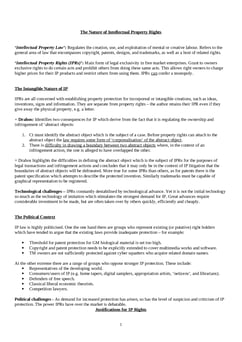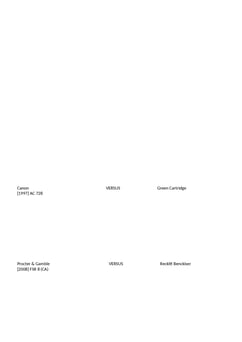Norowzian v Arks Ltd (No.2) [2000] EMLR 67
Judgement for the case Norowzian v Arks Ltd (No.2)
Table Of Contents
KEY POINTS
The legal dispute on copyright infringement involved a claimant who directed a film featuring a man dancing with extensive jump cutting to music. The key hinged on interpreting copyright law, distinguishing protection for the original creation versus its recording. The claimant argued for the former, while the first defendant created an advertising film inspired by it.
The case's core focused on whether the defendant's film reproduced a substantial part of the dramatic work in the claimant's film, with substantiality in copyright law requiring a nuanced analysis of unique elements. The appeal grappled with determining how much creative expression was borrowed or replicated.
FACTS
The Claimant, a film director, created the short film "Joy" in 1992, featuring a man dancing with surreal movements. Included in his showreel, the film was sent to advertising agencies, including Arks Limited, representing Guinness. In 1994, influenced by "Joy," the first Defendant developed the successful Guinness ad "Anticipation." The Claimant declined to direct, leading to the appointment of another director. Legal proceedings ensued in 1997, alleging copyright infringement and passing off.
The claim in passing off and against the third Defendant was abandoned during the trial. The judge, citing the Copyright, Designs, and Patents Act 1988, ruled that a film couldn't be a dramatic work. The judge also dismissed the claim that "Anticipation" infringed the copyright in "Joy." The Claimant appealed, arguing that "Joy" was a dramatic work or a recording of one.
JUDGEMENT
The Court of Appeal dismissed the appeal, disagreeing with the trial judge's conclusion that "Joy" was not a dramatic work under the Copyright, Designs and Patents Act 1988.
The court affirmed that a film like "Joy" could qualify as a dramatic work. Features like rhythm, pace, movement, arbitrary sequences, jump-cutting, and themes in "Joy" were deemed not inherently copyrightable.
The Claimant's allegation of copying specific movements was refuted, as the expert choreographer testified to the lack of significant similarity between the films. The Court of Appeal held that the trial judge's conclusions were incorrect, leading to the dismissal of the appeal.
COMMENTARY
This film-related legal case revolved around the copyright complexities of a short film, "Joy," created in 1992, and its alleged impact on the 1994 Guinness advertisement "Anticipation." The trial tackled whether "Joy" could be deemed a dramatic work and if its features were copyrightable.
The trial judge initially ruled against the Claimant, rejecting that a film could be a dramatic work and that certain features were inherently copyrightable. The subsequent appeal contested these rulings, asserting "Joy" qualified as a dramatic work.
The Court of Appeal disagreed but acknowledged a film could be a dramatic work, excluding specific features from inherent copyright protection. Expert testimony discredited the Claimant's argument about specific movement copying.
The Court of Appeal dismissed the appeal, highlighting flaws in the trial judge's conclusions, emphasizing the intricate nature of copyright law in filmmaking and the need for a nuanced understanding of artistic expression and legal protection.
ORIGINAL ANALYSIS
Claimant produced a film using editing technique called ‘jump cutting’, whereby film reels were spliced together to make a dancer perform moves that could not in reality follow on from one another.
Claimant sent film to Defendant, an advertising agency, who then produced their own film using the same cinematographic technique (although with a different dancer and on substantially different subject matter). This film was used in advertisement by Guinness.
Claimant sued Defendant for breach of copyright.
Was held at first instance that a film could not be ‘dramatic work’ as it was not capable of physical performance.
-
This definition rejected by CA, who held:
Dramatic work is any work of action capable of being performed before an audience. Thus, no need for work to be capable of physical performance.
-
Therefore a film is capable of being a dramatic work as per CDPA 1988 s.1.
I.e. provided it is capable of being played in front of an audience which will ‘often be the case’
-
Thus on facts:
-
Dance itself did not constitute a ‘dramatic work’
i.e. because it was constructed from jump-cutting, was not capable of performance
Impossible for any dancer to recreate what the dancer in film was doing
Film did constitute a ‘dramatic work’
However on facts, there was no infringement.
-
For Further Study on Norowzian v Arks Ltd (No.2)

IP law notes fully updated for recent exams at Oxford and Cambridge. Th...
Need instant answers? Our AI exam tutor is here to help.
Ask questions 🙋 Get answers 📔 It's simple 👁️👄👁️
Our AI is educated by the highest scoring students across all subjects and schools. Join hundreds of your peers today.
Get StartedSimilar Cases
Related Product Samples
These product samples contain the same concepts we cover in this case.

 Since 2010, Oxbridge Notes has been a trusted education marketplace, supplying high-quality materials from top achievers at universities like Oxford, Cambridge, LSE, Harvard, and Yale.
Since 2010, Oxbridge Notes has been a trusted education marketplace, supplying high-quality materials from top achievers at universities like Oxford, Cambridge, LSE, Harvard, and Yale.